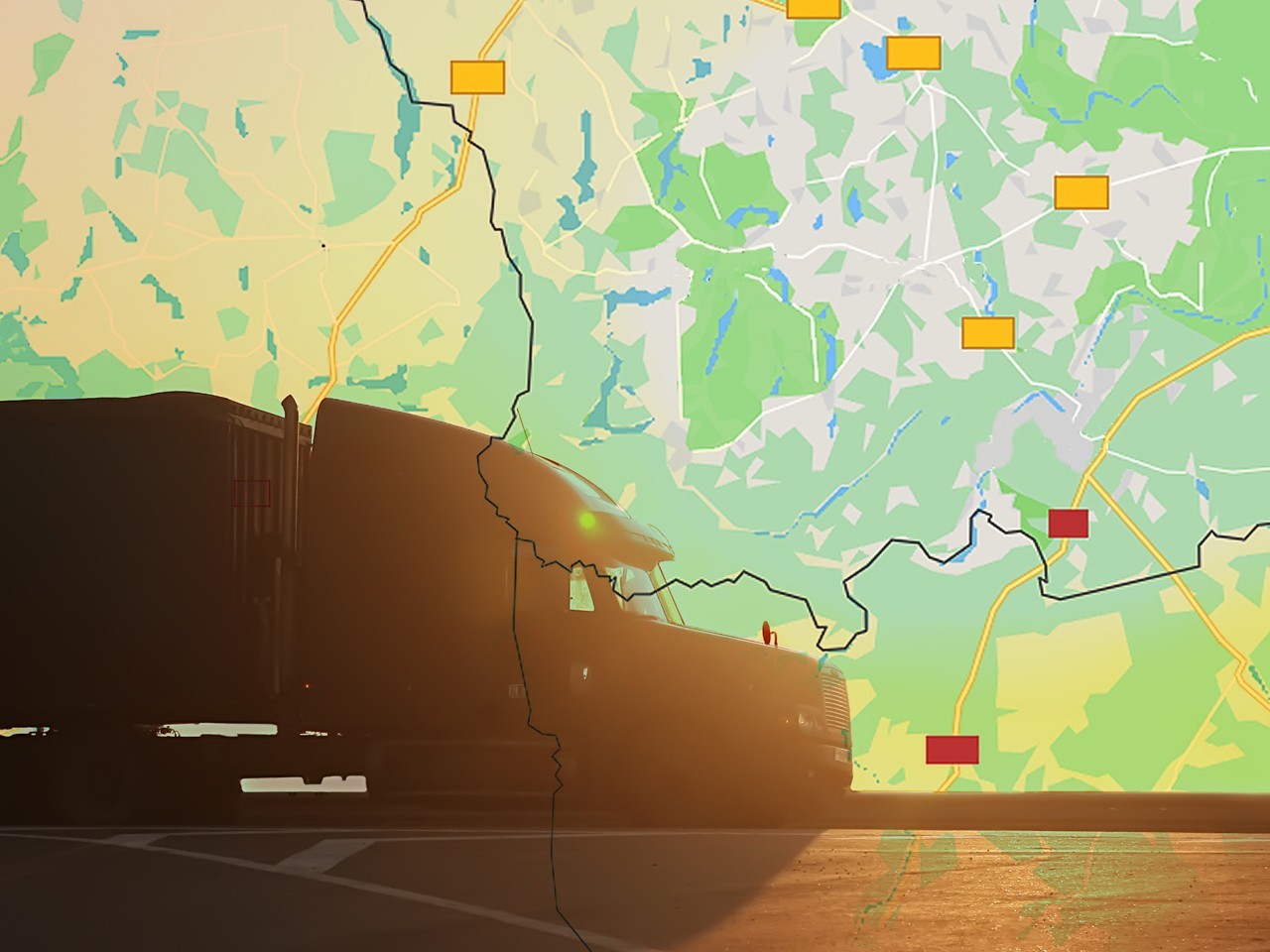The price of fuel and the rising cost of driver and fleet resources are prompting fleet operators to reevaluate their transportation optimization through logistics operations and how technology solutions can help them drive down costs and improve customer service.
Whether you operate static routes or dynamic routes that change daily, let Logistix Solutions’ on-demand transportation optimization show you how to save 15% or more in mileage and vehicle expenses and improve on-time delivery without the pain of high-cost software and implementation expenses.
Logistix Solutions’ On-Demand Transportation Optimization application (Logix™) optimizes Freight Transport and Vehicle Routing and Scheduling, based on order and vehicle information, local regulations and customer service level requirements.
Logix™ uses powerful optimization algorithms to generate freight loads and vehicle routes and schedules that save fuel costs, miles driven, vehicles and drivers while ensuring you meet all customer time windows, DOT and vehicle restrictions and operating constraints.
Google Map and Microsoft Map Point interface provides superior mapping capabilities and driving directions for unmatched ease of use and operation.

Who Should Use Logix™ Transportation Optimization?
- Shippers and Private Fleets to optimize routing and scheduling, driver and vehicle scheduling, fleet sizing, pickup and delivery and transportation management;
- Carriers, Package Delivery, Couriers and Transport companies to optimize and consolidate loads, plan multi-stop trips, schedule on-time services and develop winning bids;
- Food, grocery and beverage companies looking to optimize fleet and delivery operations;
- Logistics service providers working with clients to optimize their services.
For additional information, please call (571) 426-5951.

Transportation Optimization Features
- Full-featured Freight Transport and Routing & Scheduling tool optimally sequences stops or shipments while meeting all predefined customer service requirements (time windows and service times) and operating parameters.
- Mileage and time calculations based on Proprietary or PCMiler distances, giving superior speed, mapping quality, and flexibility.
- Output in many forms such as Route Maps, Turn by Turn Driving Directions, and Driver/Vehicle Schedules.
- Capable of benchmarking existing routing scenarios. Existing routes can be imported ‘as is’, and calculated to produce a baseline solution.
- Extensive data export options allow for interfacing with other systems and transfer of information even to those who do not have the program.
- Quick and easy implementation. The On-Line tutorial makes working with Logix™ and problem setup quick and easy. Training and on-site support is also available.
Overall Functionality
Logix™ is a full-featured Transportation Optimization tool that optimizes loads and generates routes and schedules for a given set of stops or shipments while meeting predefined customer service requirements (time windows and service times). It is a downloadable
Windows based application with a friendly user interface. Ease of use is the strength of the system. Logix is designed to manage tactical and operational route planning for daily, dynamic or master route planning operations. It can be easily interfaced with other order processing and dispatching systems to provide an integrated solution through data file transfers.
Logix™ consists of integrated Data Management, Mapping, and Routing, and Scheduling modules available on-demand and downloadable from the Logistix Solutions website. Presentation features include detailed route maps, reports, and charts for exceptional ease of use, operational visibility and presentation. All the data and solutions can be exported as text files into MS Word or MS Excel. The Mapping module was built using Google Maps and Microsoft Map Point development tools (Mapping engine) and provides a geographic view of the routing solution. Its presentation features include route maps, order distribution, and stop sequences. Transportation Optimization modules use proprietary solver engines built based on proven mathematical models to generate optimal solutions. The scheduling module presents the driver and vehicle schedules in a spatial (time) view. Various reports and export options allow the solution to be presented in numerous user-defined formats.
In addition to generating optimal routing and scheduling solutions, Logix enables benchmarking an existing solution. Existing routes can be imported into the system ‘as is’ and calculated to reproduce the baseline solution. The optimal solution can then be generated in Logix and compared to the baseline solution.
Data Management
Orders can be imported into Logix in the form of standard Excel Comma Separated Variable (CSV) files. The Logix Data Import Wizard guides users step-by-step through the setup and format process. Minimal data entry is required during setup. All the user settings are stored in the system so that repeated imports of the same format will not require further data entry, minimizing user errors.
Logix’s™ Data Summary screen presents Order data in a spreadsheet format. This screen enables users to sort the orders based on different criteria (Load, City, Zip Code, Delivery Date etc.), get more details on any Order, view any stop location using the Google maps quick plot feature. Logix™ automatically updates any changes in order quantity or dates and consolidates new and existing same-stop orders.
Mapping System
The Mapping module consists of Mapping, Geocoding, and Distance finding functionality. Logix™ uses the mapping libraries of Google Maps and Microsoft Map Point to automatically Geocode and plot stop locations and draw routes on the Map.
Map View also provides Zoom In/Out and Pan features for adjusting the view. Geocoding is automatically done before plotting the locations on the Map.

MicroSoft Map Point path finding feature can be used to generate driving directions for a specific route. The driving directions report is generated in the form of a text file that can be imported into MS Word or MS Excel and configured further according to user requirements. Microsoft Map Point is used for generating the directions report.

Routing
The routing engine uses proven routing algorithms to create optimal routes. Distance and time calculations required by the routing engine are run using a proprietary internal algorithm that can be adjusted by the user or PCMiler distances provided by the user in a table format. The internal calculations are based on City and State combination, Zip Codes, or Latitude and Longitude values and a proprietary algorithm that simulates or estimates actual road mileage base on driving distances. While building the Routes and determining the optimal Stop sequence for each route, Logix™ develops schedules based on DOT regulations as well as restrictions and constraints predefined by the user for allowable stop times, vehicle capacity and product type constraints, vehicle type constraints, region constraints, layover allowances and other factors. Planning cycles are defined by the user and can range from a single day to any number of days or weeks.
Users can choose to: simulate routes based on user input for route and route sequence, optimize routes from scratch, or insert stops on existing routes.
An exceptional feature of Logix™ is the ability to optimze cross docked loads. Loads for one or more stops that are assigned to another depot can be inserted on existing routes originating from a different depot. Cross docking can result in significant reductions in cost and vehicle resource requirements while increasing load utilization and improving delivery and warehousing productivity.
Users can also dispatch individual routes, closing them out from further optimization or stop insertion as well as delete dispatched routes. This allows for a rolling dispatch process so that new ordes are merged with existing orders and routes over an extended planning horizon.
Parameters
Routing parameters in Logix™ let users specify various restrictions and constraints to conform with Department of Transportation rules, operational or customer requirements or state and local restrictions.
Constraints can be defined for customer time windows, DOT regulations, product type, vehicle type, single or team drivers, maximum route distance, route time, number of stops, layovers, wait time etc. Vehicle definitions are also used to constrain routes in terms of availability and capacities.
Logix™ also allows users to loosen certain constraints such as customer time windows and vehicle capacities to determine the sensitivity of the optimum solution to these parameters. For example, adding a 10 minute buffer to customer time windows may allow a better solution without appreciably changing customer requirements.


Driver and Vehicle Scheduling
Logix™ uses robust scheduling algorithms to schedule the routes within a predefined planning horizon. The Driver and Vehicle assignments are presented on a chart showing potential multiple trip assignments for drivers and vehicles that meet time restrictions.
Driver and Vehicle schedules result in the minimum number of driver and vehicle resources to meet all route requirements for the time period. This allows for slip seating and continuous use of vehicle resources to further reduce costs.
Reports & Exports
Various reports can be created and printed. Order Summary, Route Summary, and Route Manifest reports can be viewed and printed. Along with MicroSoft Map Point driving directions’ reports these reports can be exported as text files and imported into MS Word or MS Excel for further configuration. A summary of the routing and scheduling solution is presented in the Analytics Screen using various metrics, charts and statistics in order to potentially compare solutions and track results long term.
Key Features & Benefits of Our Transportation Optimization Software
Logix™ provides:
- Complete visibility of the routing and scheduling solution through load and manifest Reports, Maps (geographic), and Schedules (chart) views. Consolidated view of all the routing entities (Depots, Orders, Routes, and Vehicles).
- Industry standard PCMiler distances and times can be used for routing and scheduling or Logix can generate highly accurate distances internally.
- Turn by turn driving directions for all routing solutions.
- Route generation can be simulated, optimized or inserted. Cross dock stop insertion and routing is an exceptional feature of the Logix application producing even greater savings and maximum load utilization.
- Planning can be for a day or across several days or weeks.
- Routing and scheduling solutions for North America. Street level routing (based on latitudes and longitudes) for US.
- Other geographic areas (Europe, Asia, Latin America) also available.
- Users can modify any route by moving stops or adding stops and view the resulting changes to the route sequences and maps.
- Comprehensive reports and exports of data and solution. Summary Statistics can be printed.
- User friendly and interactive interface, facilitating shorter learning curve for new users. Easy to setup the problem with minimal data entry.
- Runs in all Windows environments.
